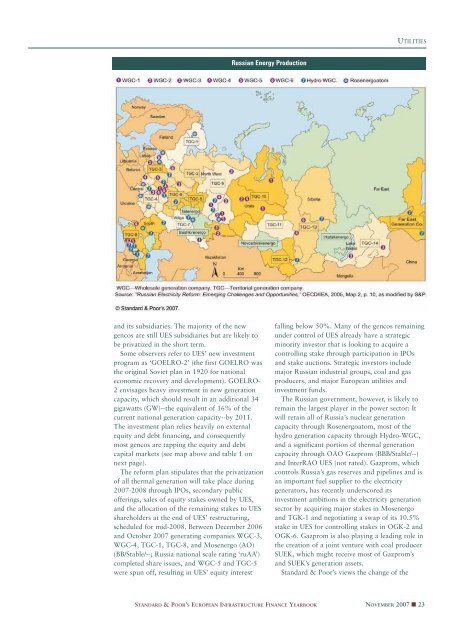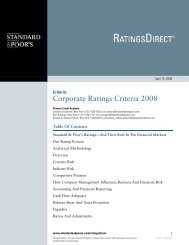European Infrastructure Finance Yearbook - Investing In Bonds ...
European Infrastructure Finance Yearbook - Investing In Bonds ...
European Infrastructure Finance Yearbook - Investing In Bonds ...
Create successful ePaper yourself
Turn your PDF publications into a flip-book with our unique Google optimized e-Paper software.
and its subsidiaries. The majority of the new<br />
gencos are still UES subsidiaries but are likely to<br />
be privatized in the short term.<br />
Some observers refer to UES’ new investment<br />
program as ‘GOELRO-2’ (the first GOELRO was<br />
the original Soviet plan in 1920 for national<br />
economic recovery and development). GOELRO-<br />
2 envisages heavy investment in new generation<br />
capacity, which should result in an additional 34<br />
gigawatts (GW)--the equivalent of 16% of the<br />
current national generation capacity--by 2011.<br />
The investment plan relies heavily on external<br />
equity and debt financing, and consequently<br />
most gencos are tapping the equity and debt<br />
capital markets (see map above and table 1 on<br />
next page).<br />
The reform plan stipulates that the privatization<br />
of all thermal generation will take place during<br />
2007-2008 through IPOs, secondary public<br />
offerings, sales of equity stakes owned by UES,<br />
and the allocation of the remaining stakes to UES<br />
shareholders at the end of UES’ restructuring,<br />
scheduled for mid-2008. Between December 2006<br />
and October 2007 generating companies WGC-3,<br />
WGC-4, TGC-1, TGC-8, and Mosenergo (AO)<br />
(BB/Stable/--; Russia national scale rating ‘ruAA’)<br />
completed share issues, and WGC-5 and TGC-5<br />
were spun off, resulting in UES’ equity interest<br />
Russian Energy Production<br />
STANDARD & POOR’S EUROPEAN INFRASTRUCTURE FINANCE YEARBOOK<br />
UTILITIES<br />
falling below 50%. Many of the gencos remaining<br />
under control of UES already have a strategic<br />
minority investor that is looking to acquire a<br />
controlling stake through participation in IPOs<br />
and stake auctions. Strategic investors include<br />
major Russian industrial groups, coal and gas<br />
producers, and major <strong>European</strong> utilities and<br />
investment funds.<br />
The Russian government, however, is likely to<br />
remain the largest player in the power sector: It<br />
will retain all of Russia’s nuclear generation<br />
capacity through Rosenergoatom, most of the<br />
hydro generation capacity through Hydro-WGC,<br />
and a significant portion of thermal generation<br />
capacity through OAO Gazprom (BBB/Stable/--)<br />
and <strong>In</strong>terRAO UES (not rated). Gazprom, which<br />
controls Russia’s gas reserves and pipelines and is<br />
an important fuel supplier to the electricity<br />
generators, has recently underscored its<br />
investment ambitions in the electricity generation<br />
sector by acquiring major stakes in Mosenergo<br />
and TGK-1 and negotiating a swap of its 10.5%<br />
stake in UES for controlling stakes in OGK-2 and<br />
OGK-6. Gazprom is also playing a leading role in<br />
the creation of a joint venture with coal producer<br />
SUEK, which might receive most of Gazprom’s<br />
and SUEK’s generation assets.<br />
Standard & Poor’s views the change of the<br />
NOVEMBER 2007 ■ 23



